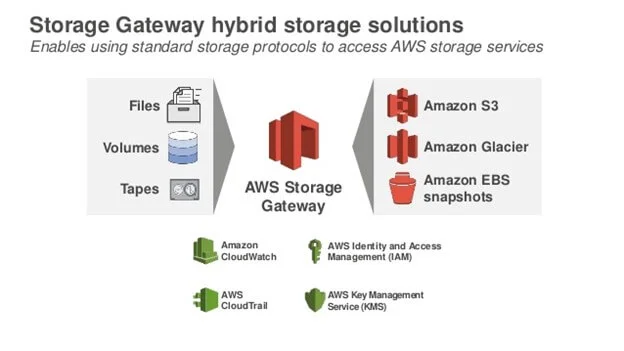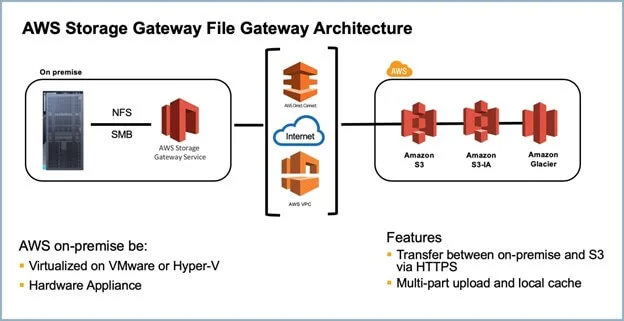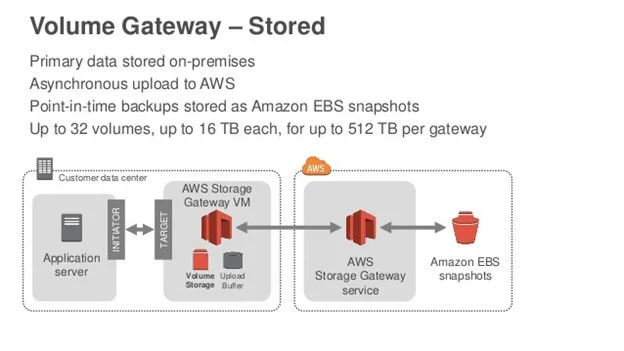Blog
Exclusive Guide On AWS STORAGE GATEWAY: Types, Use Cases & Industry Example
Cloud migration is an outstanding trend and an amazing solution that helps companies in the relocation of their entire environment. In the many available options, AWS is a hybrid cloud solution that helps companies to move away from the conventional, on-site bare metal hardware to more quick and efficient ways. This article would help you understand everything about AWS storage gateway that you need to know.
What is the AWS Storage Gateway?
AWS Storage Gateway is an on-site storage solution that enables you to combine Amazon cloud storage with the storage systems on the premises that helps in the creation of a hybrid storage environment. With the deployment of the same, your systems get access to Amazon services like S3, EBS and Glacier to practice machine learning, logging, monitoring and more. To provide a seamless experience, AWS Storage Gateway uses standard protocols like NFS, iSCSI and SMB. A key advantage of Storage Gateway is that it uses local caching to supply on-premise systems with commonly used cloud data, without the network mobility of accessing the general public cloud (AWS).

Storage Gateways: Types and Use Cases
To suit specific needs and requirements, Amazon Storage Gateway comes in three different ways, that is the File Gateway, Volume Gateway, and Tape Gateway.
-
File Gateway
It is a form of storage gateway which is used for the integration of Amazon S3 with the current, on-premise programme. For all forms of workloads that involve working with objects, it provides NFS (Network File System) and SMB (Server Message Block) access to data in S3. File Gateway provides you with not only several S3 storage classes to choose from by relying on AWS S3, but also the ability to enforce different policies on your data, or even duplicate it within other accessible regions around the globe.
Use cases
File gateway makes up for the greatest choice for various hybrid cloud workloads. For organisations relying on both on-premise and the AWS cloud, file gateway makes it possible to move data to S3. This data is also visible to your on-premise applications that can be further utilized. Another use case for this service is machine learning. Moreover, file gateway can also be used for quick and simple backups due to SMB and NFS interfaces.

-
Volume Gateway
Volume Gateway presents on-premise applications with iSCSI block storage. You can have point-in-time copies of your volumes saved as EBS snapshots by volume gateways and come in two separating operating modes which are: stored and cached. Stored amounts, while retaining an unstable copy in the S3 bucket make the entire data accessible locally on the gateway. In the S3 bucket, cached volumes store the entire volume, while only holding the recently used data in the local cache.
Use cases
Volume gateway not just helps in disaster recovery, but it also helps in backing up local data. You can easily create an EBS volume and connect it to a running EC2 example by getting a snapshot of your data on AWS, enabling you to quickly recover from an incident that affected your on-site data centre. The AWS backup service is also compatible with volume gateways, which lets you simplify backup management. This is also a great choice in case of migrating application data to the cloud. You can transfer your on-premise data to EBS volumes and run it on the cloud.

-
Tape Gateway
The tape gateway is an industry-standard which is based on iSCSI. It consists of virtual media changers and virtual tape drivers installed on-site and allow you to continue depending on your current backup workflows. At the same time, your data is written to virtual tapes that are stored in robust S3 buckets, and when regular access is no longer needed, it is ready to be archived at Glacier that further lowers down the cost. Many popular backup apps are also compatible with tape gateway.
Use cases
Tape gateways are mostly used as a substitute for old tape backup systems, without any major improvements to the current backup process being required. There is much expensive hardware involved in physical tape backup systems, and the tape management process was a serious problem. It took time and money to ship off tapes away from the premises and also made your offline data unavailable. Durability was also a problem, something that changes when using S3 and Glacier entirely.
Choosing the most appropriate and suitable solution out of these three could get tricky. All these solutions cater to specific requirements. Experts at SNDK Corp would help you pick up the best-fitting solution your organisation would need.
Industry example
Kellogg company, the world’s leading producer of cereal, cookies, crackers, frozen waffles, veggie foods, cereal bars and so much more. The company manufactures in more than 18 countries and supplies all these delicacies in almost 180 countries. In times of large scale and expanded production, AWS storage gateway helped the company to closely look at all related data easily. This not just save time and effort, but it helped the company to bring down its total cost by up to 90%.
Also Read: Explore AWS WorkSpace: Benefits, Use Cases & Industry Example
Conclusion
A storage gateway is a very versatile and dynamic solution that comes bearing multiple use cases ranging from basic backups to disaster recoveries, to data migration. For hybrid solutions, AWS Storage Gateway is the correct choice for your organisation.
